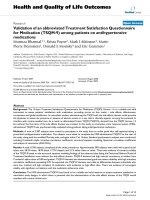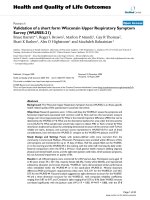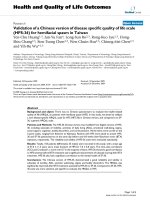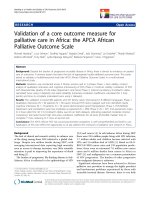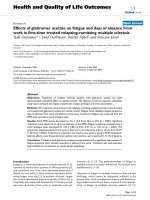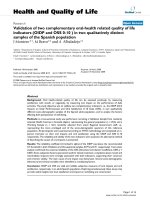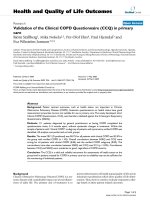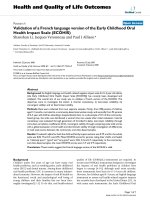báo cáo hóa học:" Validation of the Individualised Neuromuscular Quality Of Life for the USA with comparison of the impact of muscle disease on those living in USA versus UK" doc
Bạn đang xem bản rút gọn của tài liệu. Xem và tải ngay bản đầy đủ của tài liệu tại đây (463.66 KB, 38 trang )
This Provisional PDF corresponds to the article as it appeared upon acceptance. Fully formatted
PDF and full text (HTML) versions will be made available soon.
Validation of the Individualised Neuromuscular Quality Of Life for the USA with
comparison of the impact of muscle disease on those living in USA versus UK
Health and Quality of Life Outcomes 2011, 9:114 doi:10.1186/1477-7525-9-114
Reza Sadjadi ()
Kelly A Vincent ()
Alison J Carr ()
Jessica Walburn ()
Victoria L Brooks ()
Shree Pandya ()
John T Kissel ()
Carlayne E Jackson ()
Michael R Rose ()
ISSN 1477-7525
Article type Research
Submission date 14 June 2011
Acceptance date 16 December 2011
Publication date 16 December 2011
Article URL />This peer-reviewed article was published immediately upon acceptance. It can be downloaded,
printed and distributed freely for any purposes (see copyright notice below).
Articles in HQLO are listed in PubMed and archived at PubMed Central.
For information about publishing your research in HQLO or any BioMed Central journal, go to
/>For information about other BioMed Central publications go to
/>Health and Quality of Life
Outcomes
© 2011 Sadjadi et al. ; licensee BioMed Central Ltd.
This is an open access article distributed under the terms of the Creative Commons Attribution License ( />which permits unrestricted use, distribution, and reproduction in any medium, provided the original work is properly cited.
1
Validation of the Individualised Neuromuscular Quality Of Life for the USA with
comparison of the impact of muscle disease on those living in USA versus UK
1
Reza Sadjadi,
1
Kelly A. Vincent,
2
Alison J. Carr,
1
Jessica Walburn,
1
Victoria L. Brooks,
3
Shree Pandya,
4
John T. Kissel,
5
Carlayne E. Jackson,
1
Michael R. Rose*, Muscle Study
Group
1) Department of Neurology, King’s College Hospital, Denmark Hill, London, SE5 9RS, UK
2) Department of Rheumatology, King’s College Hospital, Denmark Hill, London,
SE5 9RS, UK
3) Department Of Neurology University of Rochester Medical Center, Box 673, 601
Elmwood Avenue, Rochester, New York, NY 14642, USA
4) Division of Neuromuscular Medicine, The Ohio State University, 395 W. 12th Avenue
Columbus, Ohio, OH 43210, USA
5) Department of Neurology, University of Texas Health Science Center, 7703 Floyd Curl
Drive, San Antonio, Texas, TX 78229, USA
*Corresponding author
2
ABSTRACT
Background
The Individualised Neuromuscular Quality of Life (INQoL) questionnaire is a published
muscle disease specific measure of QoL that has been validated using both qualitative and
quantitative methods in a United Kingdom population of adults with muscle disease. If
INQoL is to be used in other countries it needs to be linguistically and culturally validated for
those countries. It may be important to understand any cultural differences in how patients
rate their QoL when applying QoL measures in multi-national clinical trials.
Methods
We conducted a postal survey of QoL issues in US adults with muscle disease using an
agreed translation, from UK to US English, of the same questionnaire as was used in the
original construction of INQoL. This questionnaire included an opportunity for free text
comments on any aspects of QoL that might not have been covered by the questionnaire. We
examined the responses using both quantitative and qualitative approaches. The frequency of
the responses in US versus UK populations was compared using appropriate correlation tests
and Rasch analysis. A phenomenological approach was used to guide the qualitative
analysis and facilitate the exploration of patients’ perceptions and experiences.
Results
The US survey received 333 responses which were compared with 251 UK survey responses.
We found that INQoL domains covered all the issues raised by US subjects with no
additional domains required. The experiences of those with muscle disease were remarkably
similar in the US and UK but there were differences related to the impact of muscle disease
on relationships and on employment which was greater for those living in the United States.
3
The greater impact on employment was associated with a higher importance rating given to
employment in the US. This may reflect the lower level of financial support for those who
are unemployed, and the loss of employment related health benefits.
Conclusions
INQoL is appropriate for use in US population but there may be differences in the importance
that US subject attach to certain aspects of QoL that could be the basis for further study.
If these differences are confirmed then this may have implications for the interpretation of
QoL outcomes in multi-national trials.
Keywords
Adult muscle disease, Quality of life.
4
INTRODUCTION
Muscle diseases (MD) are a group of conditions that can be acquired or genetic and which
result in progressive shrinking and weakness of the skeletal muscle such as to cause varying
degrees of disability. The individual muscle diseases differ in their age of onset, their rate of
progression and their pattern of weakness which in turn dictates the nature and extent of the
disability that they cause. The disability caused by MD impacts upon quality of life. The
Individualised Neuromuscular Quality of Life (INQoL) questionnaire is a MD specific
measure of QoL that has been validated using a UK population.[1] The construction of
INQoL was based upon both qualitative and quantitative methods which established the face,
content and construct validity, the reliability (test re-test) and to some extent the
responsiveness of INQoL. Because QoL is a patient reported subjective measure it is
important to ensure that it remains valid when used in countries other than the UK where
language and culture vary. In order to achieve this linguistic and cultural validity for the use
of INQoL for MD patients in the United States, we needed to first agree upon an American
English translation. We also needed to ensure that the QoL domains identified in the UK
research were also appropriate for patients from the United States and check that there were
no additional domains that might require inclusion. Most publications on the differences in
QoL between countries have focussed on validation of questionnaires across different
countries rather than the actual difference in perceptions of QoL in different countries for a
given disease.[2-6] There has been no direct comparison of QoL issues for MD in different
countries. In performing our primary process of linguistic and cultural validation of INQoL
for use in the United States we gained a unique opportunity to contrast and compare the UK
and US experiences of those with MD and take this opportunity to present these results.
5
Although the use of validated QoL scales in MD does allow the collection of quantitative
data that can be used in clinical studies and therapeutic trials, the process of reducing QoL to
simple figures may obscure the experience of how living with MD really affects people.
Qualitative research such as that required for the construction of questionnaires like INQoL
does allow a closer appreciation of individuals’ experiences of living with chronic disease
and disability.[7-9] We therefore take this opportunity to report the verbal and written
comments from both UK and US patients that provide unique insights into the actual impact
of MD on their lives. While the UK quotes were the subject of qualitative analysis for the
construction of the original INQoL, they have not been previously reported verbatim.
6
METHODS
UK patients were recruited from the MD clinic of King’s College Hospital and from two UK
muscle patient support groups. US patients were recruited from the muscle clinics of three
US centres. Patients were eligible to take part in the study if their MD had been symptomatic
for at least six months. MD diagnoses were confirmed through expert opinion using standard
diagnostic criteria and confirmatory testing, including where appropriate molecular genetic
analysis, serum creatine kinase levels, clinical neurophysiology studies, or muscle biopsy.
Patients had to be aged 16 years and above and literate in English. Patients with major co-
morbidity from other active cardiac, respiratory or rheumatologic disorders which would
affect quality of life were excluded.
Patients were sent a questionnaire designed around the life domains that had been identified
during the original UK semi-structured interviews.[1] For each domain there were closed
ended questions asking the extent to which their MD affected this domain (on a five point
Likert scale from ‘not at all’ affected to ‘very much’ affected) and the importance that they
attached to this impact (on a five point Likert scale, ranging from ‘not at all important’ to
‘extremely important’). We also asked whether the impact was “good” or “bad” and
encouraged free text comments on the impact of MD on these life domains to allow
respondents to provide greater detail of their experiences and include information not tapped
by the close ended questions. The UK version of this questionnaire was independently
converted into US English by the principal investigators from each of the three US centres
(SP, JTK, CJ). Each US investigator then returned their version to the UK investigators (MR,
VB) who collated the different versions, and resolved any inconsistencies by group
discussion between all US and UK investigators to reach a consensus. Examples of
7
divergence from the UK version included word changes such as; “tick” changed to “check”,
“stick” changed to “cane” and “colleague” changed to “co-worker”.
We also collected data for respondents’ gender, age and muscle disease diagnosis. The
questionnaires were sent with a prepaid envelope for return. Non-responders were sent
another questionnaire two weeks later and further non-responders were sent a reminder letter
one week later. The study had Institutional Review Board approval from all the institutions
involved.
Analysis
For each life domain we compared the frequency distribution of UK versus US responses for
both the extent of the impact and the importance of the impact. We also computed an overall
impact score by assigning a ranking order to the product of the two factors (extent and
importance) giving an overall impact scale from 1 to 9. Due to relatively large sample size
and normal distribution we anticipated there would not be any difference between results of
parametric and corresponding non-parametric tests; this was in fact the case. Thus parametric
unpaired t-test analysis was performed to compare UK and US responses. Chi squared test
was used to compare the UK and US responses for the direction of the impact, as good or
bad. We performed Rasch analysis to examine the psychometric properties of the
questionnaire in US and UK populations. In this model, responses to each question have a
probabilistic correlation with the difficulty of the question.[10] We calculated fit of the
observed data to the Rasch model and compared responses to questions in UK and US
populations. In the course of the original UK construction of INQoL, interviews with 41
subjects were tape recorded and transcribed.[1] A phenomenological approach was used to
8
guide the analysis and facilitate the exploration of patients’ perceptions and
experiences.[8,11] Themes were extracted and clustered together into categories representing
life domains influenced by MD. A coding scheme was devised to represent the individual
domain and sub-domain categories and this was applied to the data. Finally the validity of
the coding scheme was verified through an external inspection by a second categorizer (AJC)
who applied the scheme to a sample of interviews. We applied the same coding scheme to
the free text comments given to us by both the UK and US respondents of the postal
questionnaire. SPSS for Windows version 15.0 was used for statistical tests and Winstep
version 3.68.2 was used to do the Rasch analysis.
9
RESULTS
The UK survey received 251 responses (response rate 47%) comprising 90 males and 161
females (ratio 1:2.8) ages 16- 96 (mean age 52.61, SD = 15.95). The US survey received 333
responses of which 10 had to be excluded because of missing data (effective response rate
50%). This sample comprised 176 males and 147 females (ratio 1.19:1) ages 18- 84 (mean
age 50.15 years SD = 16.16) (Table 1). Diseases represented in both UK and US samples
included congenital myopathies, limb girdle muscular dystrophies, facioscapulohumeral
muscular dystrophy, dystrophic and non-dystrophic myotonias and inflammatory myopathies.
Quantitative data
The percentage of UK and US patients scoring some impact (i.e. scoring 2 to 5 for extent of
impact), or no impact (scoring 1) for each of the domains is given in Figure 1. For the UK
population the percentage reporting some impact ranged from 45% for Work to 96% for both
Activities of Daily Living (ADL) and the Social and Leisure domain. For the US population
the percentage reporting some impact ranged from 65% for Relationship with others to 94%
for ADL.
Table 2 gives the impact scores (extent of impact, importance of impact and overall impact)
for each of the life domains and the results of the significance tests between the UK and US
samples. The overall importance score of all the relationship domains (Friends, Family,
Others and Partners) were significantly higher in US patients compared to UK patients. This
difference was not due to any difference in the extent of the impact but was due to there being
a greater importance attached to the impact of MD on relationships by the US patients. US
respondents scored a significantly higher impact in the Employment domain. For all domains
10
the direction of the impact was negative for the majority of both UK and US respondents.
What was interesting was that there was a significant minority who reported a positive impact
of their muscle disease on relationships. (Figure 2)
Since the UK and US populations differed in gender distribution we performed unpaired t-
test to explore the effects of gender on the responses. For all domains except “Body Image”
males had higher impact scores compared to females. Females reported a significantly higher
impact of their MD on “Body Image” domain than did males (Overall Impact score: mean
female rank 260.7 versus male rank 218.48; P = 0.001 ). When this was separated out to look
at UK and UK samples, UK female patients had higher impact on body image domain than
UK male patients (P = 0.001); however there was no significant difference between US
female and male patients. There was also no significant difference between UK and US
female patients in body image impact score; but US male patients had a higher impact on
body image than UK male patients (P=0.005). The difference between body image scores in
two populations is reduced by mixing UK male and female patients. Performing ANCOVA
test considering gender as a covariate enabled us to control for the gender ratio difference in
the two populations, and showed that the higher impact on employment and relationships in
the US population remained and was therefore independent of the gender ratio difference:
Employment (F=25.925,P<0.001), Relationships with friends (F=14.865, P<0.001), Family
relationships (F=12.529, P<0.001),Relationship (partner) (F=22.127, P<0.001), Relationships
with others (F=10.312, P<0.001), Body image (F=8.926,P<0.001), Perceptions of the future
(F=7.091,P=0.001)).
We also explored the possible impact of age on impact scores by splitting the sample into
those under and over 50 years-old. Those over 50 years-old had higher scores for all
11
domains with the exception of the domain “Employment” for which those under 50 years-old
scored a higher impact (Overall Impact score: mean rank for younger patients 220.46 and
older patients 168.96; P value <0.001).
Rasch Analsys
Rasch analysis gives outfit mean square values (msnq). Outfit msnq values represent the
proportion of items “out of range” ie for which there is a higher proportion of “easy” or
“difficult” responses than expected. Mean squares values between 0.70 and 1.50 are accepted
as reasonably fit in psychological studies. On the whole, the questionnaire had very good
outfit msnq (1.12). However the questionnaire items relating to “Work importance” and
“Work impact” had outfit msnq values of 2.36 and 2.06 respectively meaning that they were
the most “difficult” items for participants to endorse. This was mainly due to the effect of UK
responses to the employment question as 106 patients (42% of UK population) answered
“Employment importance” and “Employment impact” as “not important at all” as shown in
Figure 3.
Qualitative Data
Table 3 summarises the specific issues raised by these patients and how they were clustered
into the domains and sub-domains used for INQoL. The US respondents’ free text comments
gave them an opportunity to raise specific issues outside of the closed ended questions. In
general these free text comments reflected issues already raised by UK patients and therefore
already encompassed by the existing INQoL domains. Where additional specific issues were
raised by US respondents, these also fitted into the existing domains. The quotes of patients
12
illustrate the issues explored by INQoL, and provide insight into the real impact that MD has
on these patients. In some cases the quotes from UK and US patients are remarkably similar.
All the UK quotes including those in the sample given here were the ones grouped into the
broad domains that made up the final INQoL UK questionnaire. These domains clearly
corresponded across the UK and US surveys.
Daily activities
Remarks about daily activities ranged from those about personal care to others about
housework, getting around and shopping. To some extent the functional effects of muscle
weakness on daily activities were predictable and easily related to the likely distribution of
weakness in these patients. This quote
“I do have problems still when blow-drying my hair. When I hold the hairdryer for a long
period, my arms start to feel heavy and tired.” - UK patient
reflects proximal upper limb weakness while this one
“Difficulty in getting from a sitting position to a standing position, difficulty in retrieving an
object off the floor, difficulty in use of fingers to grip objects, to write a letter, to do personal
hygiene, difficulty walking without aid and decreased stamina when ambulating for long
periods of time (20-30 min).” – US patient
reflects mostly proximal lower limb weakness but with some hand weakness also. What may
be less appreciated by medical professionals is the degree to which fatigue and pain impact
upon daily activities as evidenced by two similar quotes from UK and US patients;
13
“I do not have the strength/energy to sustain normal day-to-day living activities for more than a
couple of hours. I become overwhelmingly tired and my muscles ache so much I cannot do
anything or even concentrate on sedentary activities. This is despite painkillers. I only recover
after lying down for a couple of hours. It takes so much effort to get through the basic needs of
living that there is no energy/time left for social activities. The almost constant pain affects
concentration too.” – UK patient
“I am not able to participate in sports anymore and at social functions, around 2-3pm, I fall
asleep.” – US patient
Employment
Many comments were made about respondents’ working life. These related not only to the
effects of MD upon working activities but also upon job prospects;
“I was made redundant three years ago when the company I had worked with for 17 years
relocated. I firmly believe that the reason I was not able to get another permanent job was
because of my condition.” – UK patient
“I lost my job due to weakness & fatigue. Most of my co-workers were working 12 hour shifts.
There is no way I could do that. I loved my job & did not want to go on disability (benefits).”-UK
patient
Many respondents commented on their having to take early retirement on ill health grounds,
or upon the adaptations they had made to their jobs or career path. The impact of stopping
work upon self-identity was clear;
“(I) Had to retire from work at age 35 – (this) had a huge impact on how I saw myself as a
contributing member of society.” – UK patient
“(I) Had to retire at 53 because of my muscle problems – loss of 60% of my income & my health
insurance was cancelled after 30 years at the same company.” – US patient
14
Social and Leisure Activities
Respondents also commented upon the impact of their condition upon leisure and social
activities. Both sporting and sedentary activities were influenced. Difficulties socialising and
visiting friends and family were commonly reported and these were linked to transport
problems and difficulties in accessing buildings and homes;
“This illness affects all my leisure activities, as I’m in a wheelchair. I’ve had to give up dancing,
gardening and even visiting friends and shopping. Even my son and daughter I cannot visit as
there are steps which I cannot get up over. Some shops have a ramp or are level but a lot aren’t.
I have been confined to the house for 5 months due to the fact I could no longer transfer from the
car to my wheelchair. After 5 months of worry and expense we have just had a car converted for
me to drive.” – UK patient
“It’s hard to do some of the things I like to do, like go for walks, ride bike and hang out with my
friends.” US patient
Relationships and Social Interactions
Some respondents commented that friendships had faded as a result of the difficulties in
taking part in activities previously shared with friends;
“A lot of “friends” simply drift away when it is obvious there is a chronic condition which is
unlikely to change, and when one can no longer go out and about to mutual interests or be
relied on to entertain at home. Someone who would rather go to bed than even sit and talk
becomes of little interest to any but the most long suffering of friends.” UK patient.
Many respondents felt that there was a lack of understanding about MD and its effects. This
made the condition difficult to explain. In particular patients with myositis frequently
15
commented upon the difficulty they had in explaining their condition to other people. This
was believed to be due to their appearance of physical well-being;
“The main problems lie with the condition not showing any visible signs and symptoms and often
having to explain oneself or making excuses for inabilities.” – UK patient
“Many people do not see my handicap on the surface. My job does not entail heavy lifting, getting
up and down heavy stairs or ladders, so many do not know of my handicap. Only when we are
invited to participate in activities where there will be physical activity will I make excuses not to.”
– US patient
Some patients also commented upon the lack of understanding about their condition, not only
in other people but also in the in medical profession. This was a source of great distress;
“They and also medical staff have never heard of “Inclusion Body Myositis” – UK patient
“You’re not that bad.” – US patient referring to comments about relationships & social
interaction.
“Most people don’t understand Inclusion Body Myositis. Of course, this is also true of doctors” –
US patient.
Family
An immediate effect upon some respondents’ behaviour towards their family was evident;
“I find myself distancing myself from my family. If I am too caring I may be expected to
physically do something to show that I love them. I used to do it in the past, even though I
suffered for it- their needs were met whilst I cried alone in pain. I’m continually trying to balance
my relationships but this year have felt, I just want to be left alone so that I can at least cope and
have enough energy to be reasonably cheerful and good company for my husband who I am sure
you appreciate has had a lot to cope with himself. To be honest I don’t answer the phone or the
16
door while my husband is at work and when he comes home I let him do it.” – UK patient
“Due to my limits I find I am a bit more concerned about my relationships with other close family
members. I require more from them.” – US patient.
Problems of access to the homes of friends and family and to social venues were also a
source of difficulty for relationships.
Partners
A large proportion of the respondents commented upon the impact their condition had
exerted on their relationship with their spouse or partner;
“My muscle condition, weakness (and) tiredness destroyed my marriage in the end. I’m now on
my own and can see no future with myself ever having a relationship with anyone ever again, it’s
just too hard.” – UK patient.
“My spouse divorced me. It’s been about two months. We were married for 24 years.” – US
patient
“We don’t share activities any more, we can’t go on same kind of holidays we used to, I’m a
nuisance when we go out together, and I’ve gone off sex completely. I can’t see why he still
bothers with me.” – UK patient
“How could it not affect spouse. Walking slowly, vacation planning, lack of spousal relationships,
loss of 60% income – wife had to go back to work & my only son just started college.” – US
patient.
A number of respondents also commented upon the difficulties they had in meeting potential
partners;
17
“When it comes to a partner, everything is fine until I mention my illness, in which case they don’t
want to know.” – UK patient
“I am filing for a not to be with my wife & I am having a hard time with getting or staying with
someone because of this.” – US patient
However, the support provided by respondents’ families and partners was also clear from a
number of comments;
“When I finally get diagnosed my fiancé and friends were really supportive and helped me to get
through the most difficult times.” – UK patient
“My family & friends are very supportive of my MD in that they help with stairs, getting up from
chairs etc.” – US patient
The themes relating to emotions and other psychological issues were very much intertwined
and respondents tended to comment upon the emotional impact of MD in the context of the
other life domains. For example, patients’ fears about the future had a considerable impact
upon the emotional feelings expressed.
Independence
Independence was alluded to a great deal by both UK and US subjects;
“I have to totally depend on others for just about everything. I can use my hands to eat and
drive my mobile chair. I can’t comb my own hair; I need help to take a bath, use the toilet
and to get in and out of bed. Also to sit up. I am totally dependent on others. I can take my
own medicine whilst sitting.” – US patient
18
Independence was sometimes mentioned with particular reference to one’s spouse;
“I am very dependent on my husband and this affects me emotionally. I feel a burden
sometimes, although he doesn’t complain.” – UK patient
Independence was also intertwined with perceptions about appearance, fears about the future
and religiosity as coping strategy;.
“My independence is gone, that is what hurts most of all. I used to be proud of the way I used to
look, but not now with my weight loss. The little use of my hands, feet, throat and neck control, it’s
hard to think of what the future might bring. I just ask my Lord to walk with me and help me carry
on”… - US patient
“Sometimes I feel well balanced and happy and yet other times I feel sad and lonely even though I
have a wonderful family. I picture my future as being on my own, ill and more dependent than I
am now, but I try not to think about the future.” – UK patient
Perceptions of the Future
Patient’s perceptions of the future were linked to becoming a burden on family;
“My thoughts about the future are very fearful. I know this illness is supposed to be slow in
progressing, but how slow? At the moment I can only stand for a few seconds and if I dare bend
my knees I’m on the floor in one untidy heap and can only get up with my husband’s help (and)
with a hoist. So I cannot walk or stand. I cannot lift my head off the pillow when I’m in bed and
it’s very difficult to turn over in bed… what happens if I get worse. My husband is seventy-five.
What will happen if he dies?” – UK patient
“What future independence! I’ll be getting weaker and end up in a wheelchair with people waiting
on me.” – US patient
19
Other concerns about the future related to the genetic nature of some muscle diseases. A
number of respondents were worried about the possibility that they had passed on their
condition to their children. They also had concerns about being able to physically care for
their children in the future;
“I tend to worry a lot about how much of a burden I will become to my family, my wife especially,
as I get more immobile. Also I worry a great deal about what I have passed onto my daughter.
They learnt about genetics at school, so they know that it is passed on, but I was told by a doctor
at an FSH (facioscapulohumeral muscular dystrophy) get together not to have them tested unless
it was absolutely necessary as the tests were not always conclusive.” – UK patient
“I have a little boy, who I feel may have my condition or worse. I can’t imagine how hard it would
be for me to take care of him if my condition should happen to worsen. That is my everyday worry
– towards the future.” – US patient
Self Image, Identity and Body Image
MD itself, but also its treatment, had effects on actual physical appearance;
“I hate the way long-term steroid medication has made me look. I cannot bear to look in a
mirror and I just cannot look at photos of myself taken before my condition.” – UK patient
In other cases the effect on body image was more to do with the way it affected one’s
mobility;
“I feel like a second class citizen as I use a walker and I feel like people are looking down on me
because I have a problem walking and getting around.” – US patient
20
Loss of independence and its consequent dependence on others had a considerable impact
upon patients’ self-image and sense of identity;
“I don’t really have any independence. I think I must have lost the will to even want to be
independent. I don’t feel like I’m a person any more- maybe just an extension of my husband most
of the time, which is not so bad because he’s a really nice guy!” – UK patient
Subjects’ perceived poor body image could also contribute to social isolation;
“(I) Stay away from people that know about my condition, then I am just me.” – US patient
Sex
The impact of MD upon body image also had implications for social and sexual confidence;
“I’m very self-conscious when it comes to the sex side of the relationship and I want to hide
myself as much as possible. Consequently I find myself “putting off” the physical side of the
relationship and so not encourage it even though we both still enjoy it when it does happen.
I'm a bit overweight because of lack of exercise so I am trying to cut down my intake of
food.” – UK patient
Physical impairments also made sexual activity difficult for some;
“The only deleterious effect on my relationships has to do with my wife. It prevents me from
being as agile as I would prefer during sex.” UK patient
21
Coping
A variety of recognised coping strategies were employed by those with MD. These included
a) planning;
“Because of the condition it is not easy to do things on the spur of the moment. It is not always
practical to go to places that are new to me without a bit of forward planning. For example, are
there stairs or lifts, how far is it to walk, what is the ground like?” – UK patient
“…when I fly I order a town car to take me to the airport, I order a wheelchair to be waiting at
the church and order another for my destination… I get into a car better on the driver’s side, so I
request that I sit behind the driver…” – US patient
b) focusing on the immediate day to day issues with a element of denial of the future;
“The future frightens me, so I have trained myself not to think too far ahead and to enjoy what
independence I have today.” – UK patient
“I live day by day and am doing fine.” UK patient
c) comparing one’s self with less fortunate individuals;
“However, I consider myself blessed and try to use my heart to be of help to others in worse shape
than I.” – US patient
“After reading what other folk have gone through I feel very fortunate to be as healthy as I am.” –
UK patient
d) remaining optimistic;
“I am optimistic about the future, which will involve study, more sedentary hobbies and refusing
to be beaten by this disease.” – UK patient
“Well I am a complete optimist and I go day by day so I feel rather good on emotion since I don’t
get as much pain as I used to and I can handle the tremor. I am doing all right.” – US patient
22
e) acceptance and changing expectations;
“One has to accept that there are many things one can no longer do- if these are very
important one has to ask for help- if not the there is a conscious decision to do without or
accept a lowering of expectations and a compromise on previously acceptable standards.” –
UK patient
f) religion;
“At the age of 72, my best way to maintain peace/comfort is with my good wife and prayer.”
UK patient
23
DISCUSSION
The results of this analysis show that the quality of life domains used by INQoL effectively
captures the experiences of both UK and US patients with MD. The quantitative data shows
that all the domains were embraced by US patients as they were by UK patients. The
qualitative data suggests that the issues raised by both UK and US populations are very
similar and no new items were identified by the US survey that could not reasonably be fitted
into the domains already chosen. As with all such studies selection and responder biases
raise questions about the generalisability of our findings but the sample sizes are large for
these rare diseases and the findings are in accordance with our clinical experience. For the
majority of both UK and US patients muscle disease had a detrimental effect on quality of
life domains but a significant minority reported a beneficial effect on relationships. In
interviews this minority reported that their muscle disease had made them closer to family
and friends for a variety of reasons.
The significant quantitative differences in the domain impact responses between the two
countries are of interest but cannot be assumed to be simply due to cross cultural differences.
There are a number of potential differences between the UK and US populations that may
have accounted for different response rates. One known difference between the UK and US
populations is gender distribution. Our analysis suggests that this may explain some of the
differences in that males scored a higher impact for most domains than did females with the
exception of “Body Image” where females scored higher. The two samples were fairly
similar in age distribution and so the differences in responses we found between those under
and over 50 years-old seem unlikely to account for any difference in responses of the UK
versus US populations’ responses. Similar issues were raised in a study of the effect of
epilepsy on psycho-social factors which showed US, New Zealand and UK subjects had some
24
different scores but that interpretation of these was confounded by various demographic
variables and the unknown differences in the type and severity of the epilepsy in the three
national groups.[12]
Other important factors to consider would be the distribution of specific muscle disease
diagnoses, and the range of muscle disease severity. The UK and US population were
recruited in different ways which is likely to have led to differences in disease distribution
and severity. Such differences may have had an important bearing upon interpretation of any
differences in impact scores not just those between countries but also those between other
groups such as gender. That females report more impact of their MD on Body Image might
be considered not surprising. However, in order to fully appreciate whether this is a true
gender difference, one would have to take account of the specific muscle diseases present in
the male and female populations and the severity of such diseases. Some muscle diseases
have more obvious effect on Body Image than others. Facial features such as facial weakness
in facioscapulohumeral dystrophy, or ptosis in myotonic dystrophy may mean these diseases
impact more on Body Image than does limb girdle muscular dystrophy which usually has no
facial involvement. Inflammatory muscle diseases are treated with steroids which may have
side effects such as weight gain, moon face, hirsuitism, and buffalo hump that may
disproportionately affect Body Image. More severe muscle disease affects the gait and
movements generally and can of course mean that one is obliged to use a wheelchair. Some
patients referred to these aspects when explaining the impact of their MD on Body Image.
If however the differences in disease impact recorded by UK and US populations reflect true
cross cultural differences, this raises further interesting questions for research. The greater
importance that the US population attaches to Relations with family and friends may reflect


